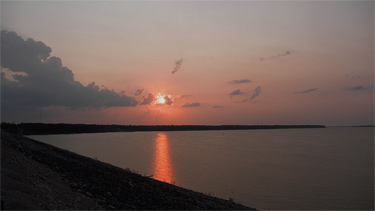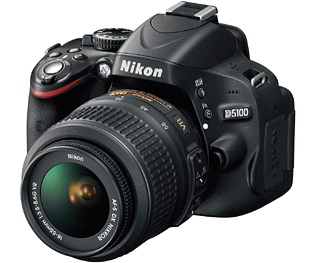Is DSLR Video User Friendly?
JOHNSTON, IOWA—When I was in the 6th grade, I received my first 35mm camera, an Edixa Reflex. It was a completely manual camera and as I recall it had a split image focusing screen which I still fondly remember as being the easiest way to focus a camera. (OK, my Polaroid Swinger did actually light up and say "YES" when the image was in focus but the finished product from the Swinger couldn't hold a candle to what came out of the Edixa.) I used the Edixa all through high school and into college but the camera mechanics were worn and finding lenses became a challenge so I moved to a Konica and then a Minolta. Now I am in the market and once again I am looking at a 35mm still camera and I recently had an opportunity to try out a Nikon D5100.
Despite working in television for the last 30 years and learning all about video, I have never really wanted to shoot video. For me, capturing a moment in time in a still image is more enjoyable then trying to capture an event in motion which is why I have always enjoyed shooting with a 35mm SLR camera.

This image is from a 1080p sunset sequence that included a slow pan from left to right in challenging light. Despite the motion, a 35mm still image with no blur could be extracted. Of course looking at most modern DSLRs, the ability to record video is included but this typically hasn't been a specification that I seriously considered. But within the D5100 is the ability to shoot high definition video in 1080p at 30fps. I found this to be intriguing given the relatively inexpensive cost of the camera body at just under $800 and just under $900 with a standard 18-55mm lens.
Add a reasonably priced telephoto lens and for somewhere less than $1,500 you have a pretty slick HD camcorder.
WHAT THE HECK
Now I have already said that shooting video has not been my target, but since I was demoing the camera, I thought I would check out its video capabilities in the event that we might try to incorporate them into the operations at IPTV. The first thing I will tell you is that if you're going to shoot video with this or any other DSLR always carry and use a tripod. The camera is so light, even with a 300mm telephoto lens attached that I could see the picture move with my heartbeat when shooting handheld with my arm against my chest.
The other issue for me was using the little flipout screen. The few times I have actually shot professional video, it has been with a shoulder-mounted camera with an offset viewfinder which allowed me to use one eye to maintain the image in the frame and the other eye to see the surrounding environment. With the LCD, I found myself more watching the television than capturing the event and on a couple of my tests, I missed some interesting ancillary action. And of course there was also the issue of the LCD performance in bright sunlight, but the articulated mount made it pretty easy to angle the display for reasonable performance.
The quality of the video was exceptional but be warned, standard SD memory cards fill up extraordinarily fast despite using an AVC-HD codec instead of Motion JPEG as in earlier models. Since I was only shooting brief videos for testing, I had a bunch of 2GB and 4GB SD cards available, but if I were actually going to do any serious video recording I'd be stocking up on SDXC or SDHC cards. (As a side note, there is some discussion that SDXC cards are faster than SDHC cards. Whether or not that would make a difference in acquisition or off-loading video, I am not sure.)

Nikon D5100STUNNING RESULTS
I looked at raw video on the 23-inch display on my computer and it was amazingly clear. I think this may be the first time I have looked very closely at 1080p. I also loaded it on a laptop and sent it via HDMI to my 65-inch home television with equally stunning results, although the drive on my laptop had a hard time keeping up and the video glitched a few times. One video in particular caught a hummingbird feeding on my porch and went through the sequence frame by frame and it appeared to me that I caught an amazing sequence of stills that I would be very happy with. For someone who prefers shooting stills to video, this is a pretty amazing event.
The D5100 does include an onboard microphone that would be OK for home video but it does include the capacity for an external stereo microphone feed. If I were to consider using this camera in a professional environment I would probably come up with an external mixer that would allow me to take a feed from a sound system as well as outboard microphones. Remember that this camera is not a "professional broadcast camera" so it doesn't include things like timecode for editing.
Speaking of editing, that is the one area where I was unable to actually do any tests. I tried on my home system but unfortunately I kept locking up both of my consumer video editing packages. E-mails to the support staffs at both companies revealed that the versions of software that I have don't support 1080p and I would need upgrades. I may have to make the investment in new editing software but that depends on whether or not my wife picks up the hint and buys me a new Nikon D5100 for my birthday. Who knows, I may even start shooting videos.
Bill Hayes is the director of engineering for Iowa Public Television.
The professional video industry's #1 source for news, trends and product and tech information. Sign up below.
Bill Hayes is the former director of engineering and technology for Iowa PBS and has been at the forefront of broadcast TV technology for more than 40 years. He’s a former president of IEEE’s Broadcast Technology Society, is a Partnership Board Member of the International Broadcasting Convention (IBC) and has contributed extensively to SMPTE and ATSC. He is a recipient of Future's 2021 Tech Leadership Award and SMPTE Fellow.

